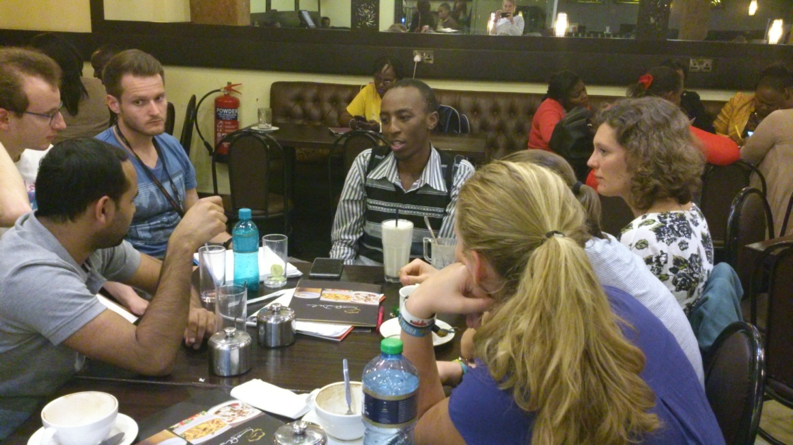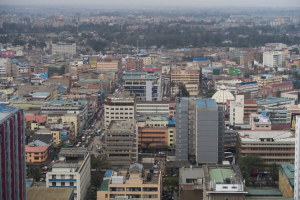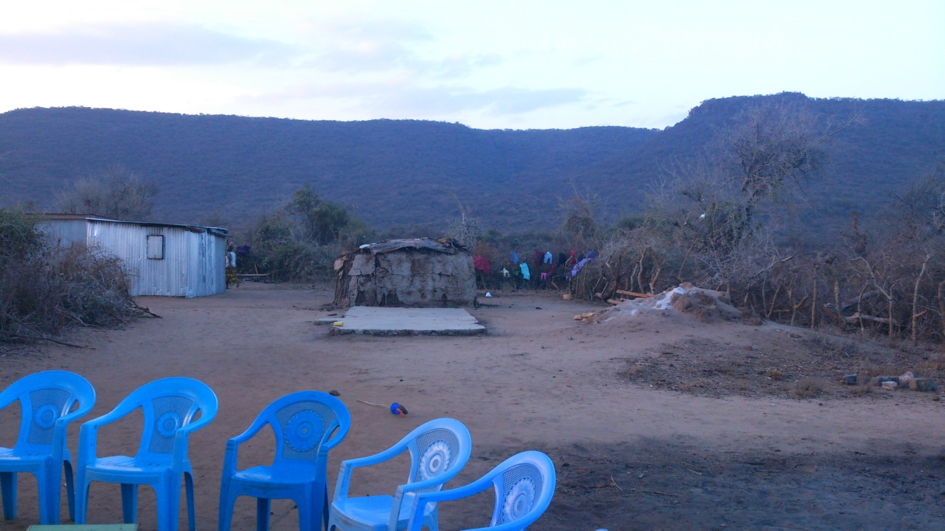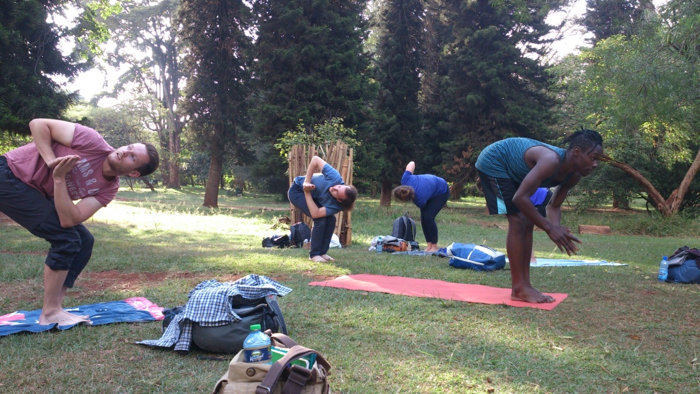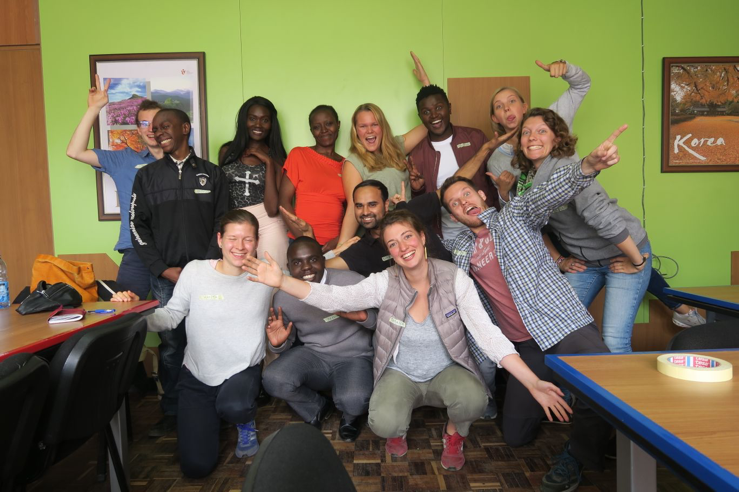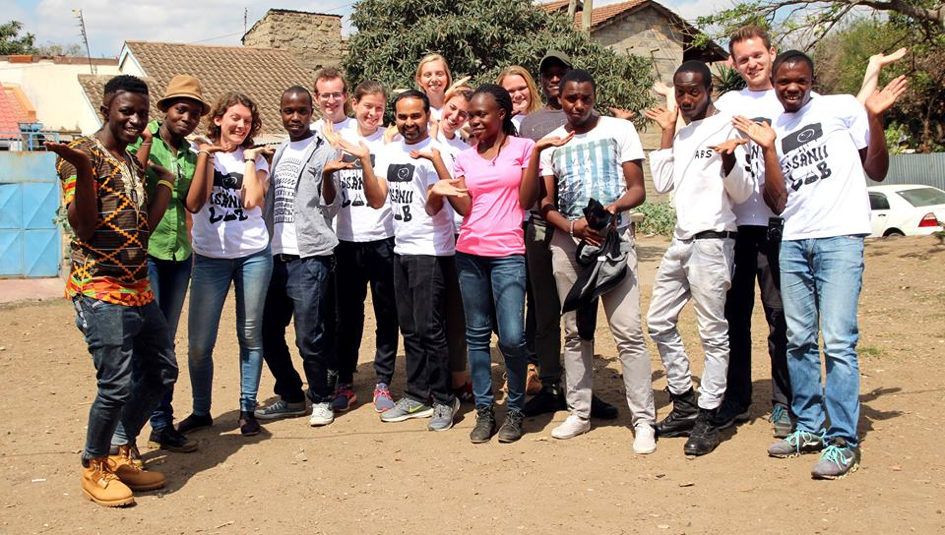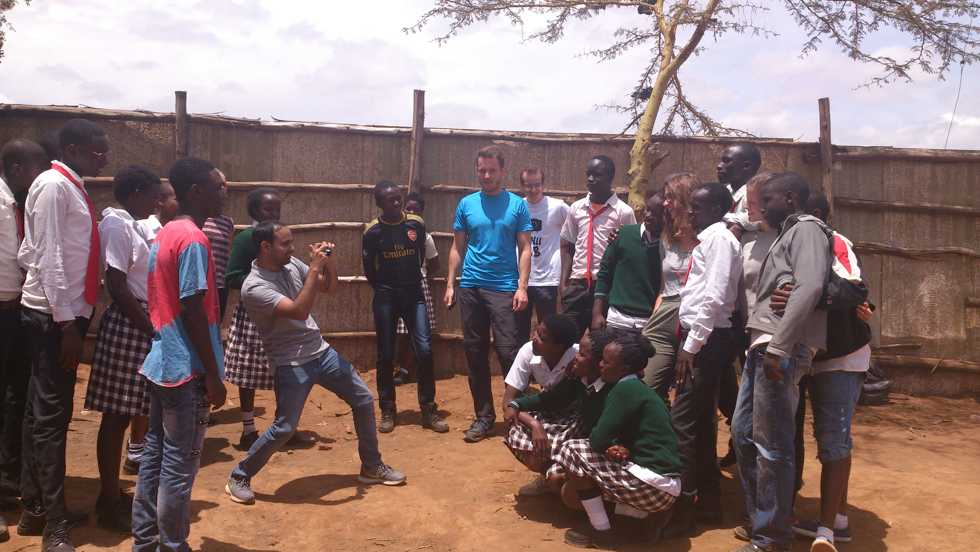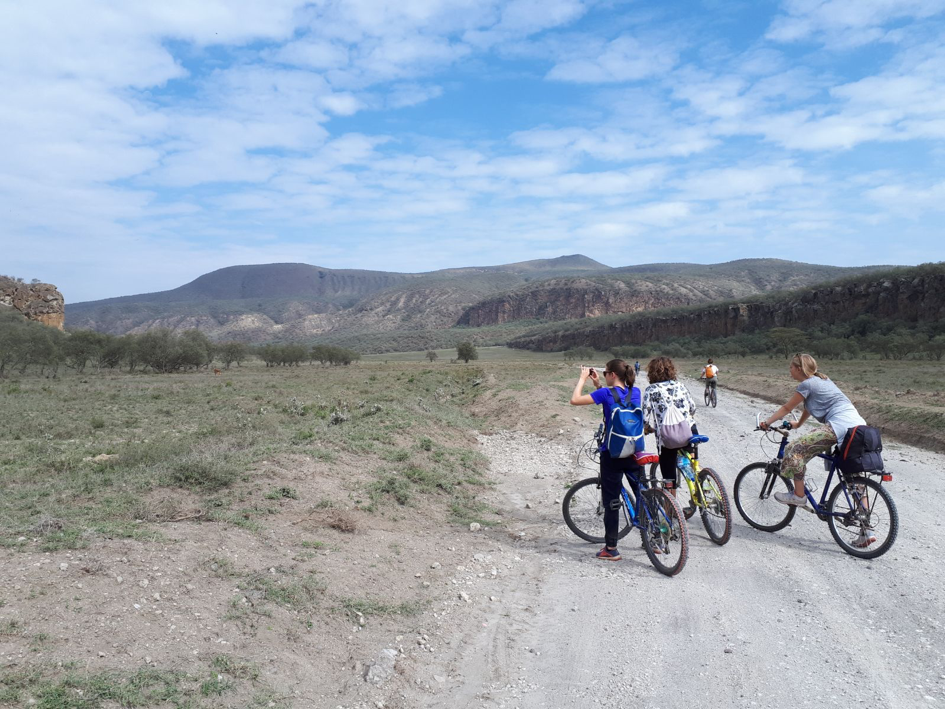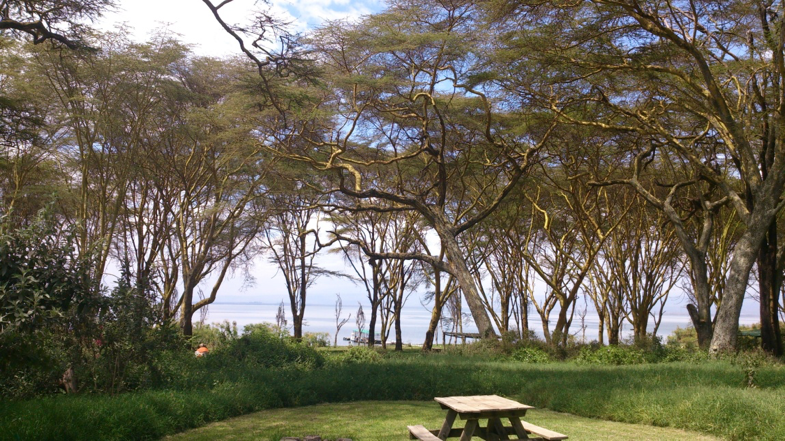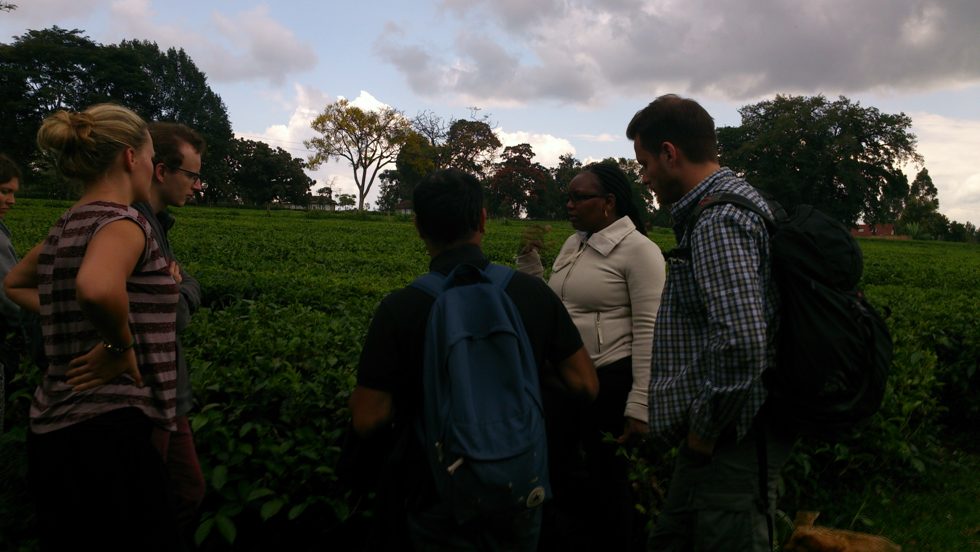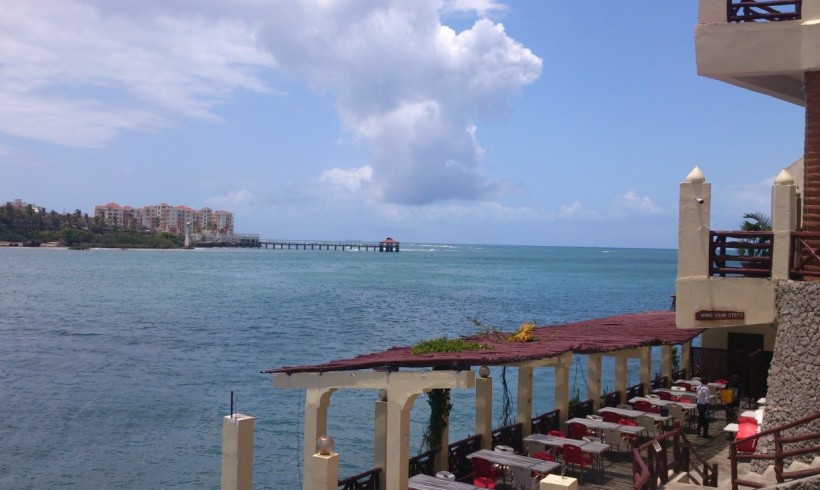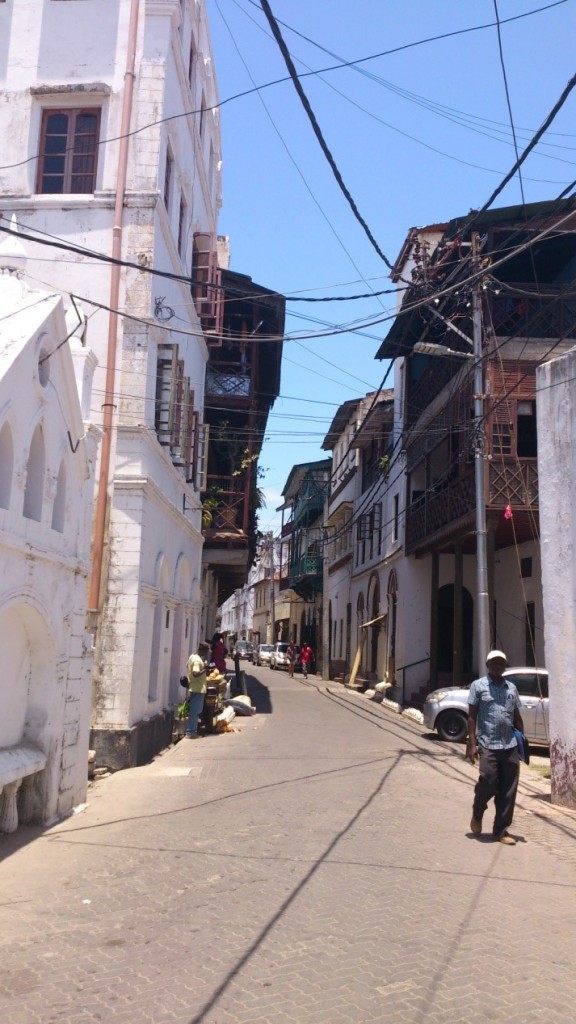Day 1
by Tamara
The first day started on the rooftop of our bed and breakfast in down town Nairobi. We got to know each other a little bit better despite the fact that some of the group had already met each other at the pre-meeting in Zurich. After a general instruction, Jasna and Caro (the two organizers) gave us some more detailed information about the trip. After that we had time to settle in at our room. For dinner we experienced typical Swahili food for the first time. This was a perfect start to learn something about the local culture. After dinner we all were really tired and went to bed early to be ready for our Swahili lesson the following morning.
Day 2
by Nicole
At 7 o´clock we went on the terrace to get breakfast. After stuffing our bellies with fruits, coffee, eggs pancakes and other delicious things we walked to the Matatu station. Matatus are private run Minibusses that drive to a pre-defined place. They don´t have a schedule, most of them leave as soon as they are full. Some of them are decorated with slogans, graffities or colored patterns, some play loud music and some even have TVs inside.
We drove with our Matatu till Buru Buru, where Jasna tapped the conductor on the shoulder to get him to tell the driver to stop. “Karibu!”, welcomed us Dilmann and Frank, as soon as we got to the office. The next two hours we were going to learn the basics of Swahili. Dilmann is a very motivated teacher; he even made us sing a Kiswahili song!
After the Kiswahili lesson we drove to the city center, accompanied by our three guides. Our Matatu had 12 screens which showed a rap music video and the music was so loud it made the whole bus vibrate. A real experience! After lunch, our guides lead us to the KICC (Kenyatta International Convention Center), where we went up to the 27th floor. From there we got an amazing view of the city. The next stop was the Uhuru Park. Uhuru means “freedom”, the park got this name because after Kenya gained independence in 1963, one of the first meetings took place in this park.
Soon we all needed coffee and headed to Java Coffee, where we also enjoyed an amazing chocolate fudge cake. There we also listened to Adrians presentation about human rights, which prepared us for the meeting of tomorrow. As the sun went down, we started walking back to the hotel. The busy streets of Nairobi in the evening lights were a wonderful end to a perfect first day in this fascinating country!
Day 3
by Adrian
We started this day at around 8:00 by having breakfast on the rooftop of the hotel, just like yesterday. However, we learned our lesson from the previous day and did not order as much food as yesterday and thus left the table with a happy stomach. The weather was still a little cloudy, but there was no rain anymore and it was also a bit warmer than the day before. At around 8:30, we left the hotel and went to the office of a Human rights organisation called HAART (Awareness Against Human Trafficking) to learn more about what human trafficking is and about how to deal with the issue. The office is in the same building complex as a church, which we shortly visited.
After a while, a woman invited us to a small conference room, where we could wait until the project leader arrived to tell us more about HAART, their work and human trafficking in general. In the meantime, we talked to the lady about her work at HAART. She is a psychologist and assists people who come to HAART and which have been trafficked, to help them recover from their trauma.
After a few kenyan minutes, the project leader arrived. After everyone introduced themselves and after we talked a bit about what we already knew about human trafficking, she began to explain more about the subject. She started by defining the term “human trafficking”, which is in fact very important for people to understand so that they can become more aware of the issue. In fact, she told us that sometimes, the victims themselves (in particular children) are not aware that they are being exploited.
She explained to us that human trafficking is happening whenever someone acts (like transports, recruits,…) via coercive means (like physical or psychological pressure) on someone to exploit that person (like forced labor, prostitution or even removal of organs). She further explained that the most common type of human trafficking in Kenya wasKenyan people being transported to countries like Libya or Saudi Arabia to do forced work there, or also that children were taken away from their parents to be forced to work. The lady also told us about her work, consisting of raising awareness in schools, churches, but also among police forces. The latter ones are usually very difficult to cooperate with, since they rarely recognize human trafficking as a problem and put the victims, which may have been brought from different countries to Kenya without a passport, in jail.
After saying goodbye to everyone, we travelled back to the city center. There, we went for lunch and afterwards split up to buy some food for the next day. We then all met at a little café at around 15:30 to speak with George, who studies politics and is also a blogger ( epickenyan.com ). He told us about that the overall low interest of the Kenian youth in politics and about how hard it is to convincce them of the importance of them gaining political power. He showed us a presentation analysing why this was the case and about what could be done to make politics more attractive to young people. For example, he told us about the fact that most of the youth in Kenya is interested about politics only during election time, or that sometimes parties gave money to people who are going to vote, thus making it more attractive for people who are poor (and also making them vote for them). But we also talked about the educational system in Kenya and some of its flaws, or about the recent elections. After our talk, we went back to the hotel to enjoy a nice dinner.
Day 4
by Kush
We started the day with our customary breakfast on the rooftop of our hotel at 8am. The agenda of the day included a visit to the UN office in Nairobi in the morning and then a visit to the Women’s rights organization in a Masai village near Kajiado in the afternoon.
We arrived at the UN office at around 9.30am. It is one of the four major UN office sites in the world. Our tour guide, Lisa, was an intern working at UN. She started the tour with an introduction to the children’s stationery and toys boxes which are sent to war-zones and refugee camps. Then, she delivered a brief presentation giving an overview of the UN in general and the UN office in Nairobi in particular. She told us that the two main programmes headquartered at the Nairobi office were UNEP (United Nations Environment Programme) and UNHC (United Nations Human Settlements Programme). After the presentation, we were shown around the UN building complex which houses a green and carbon-neutral building. The guide led us to the green park area where different leaders of the world had planted trees. The tour culminated at the memorial for US embassy bombings which contains the peace emblem. After a short coffee break at the UN canteen, we left for our next meeting. We picked up James, our liaison with the organization, from the city center and then drove for around 2.5 hours to the village.
Most of us were expecting an office for the organization, and thus were surprised when we realized that it was just a small community of women living within the village. James accompanied us to the organization members. They were very warm and welcoming, and had prepared a delicious meal of chapatis and potato/goat-meat curry. After satisfying our appetite, the leader of the group gave us an overview of the organization, how it came into effect, its goals and challenges and some of its current works. It was really inspiring to learn how these women banded together to fight against their societal issues and to become socially and economically self-dependent. We learned about the issues of education, female genital mutilation, common wedding practices and also about their financial avenues such as soap-making, selling meat, handicrafts etc. The presentation was followed by a lot of questions from us and we were also a bit surprised that these women were very open to discussing even very sensitive issues.
After the visit, we drove back to our hotel where we had our dinner along with a feedback discussion about the day.
Day 5
by Tamara
In the morning, George – an old friend of Jasna and a very good driver – picked us up and we drove to Buruburu. Jasna used to live there and introduced us to a typical Kenyan market. There are a lot of second hand clothes and delicious fruits like pineapple, bananas, papaya and grapefruit. We had the task to present a citizen of Nairobi to the group and as a group of “mzungu” we got a lot of attention and it was easy and really interesting to talk to locals. Jasna is very keen on the food chapati with avocado, so we decided to try it for lunch. Due to the fact that people do not eat on the streets, often as a sign of respect to the poor people, George was very kind and hosted us at his place in Buruburu. It was a really nice experience to see an apartment of a citizen from the inside. After lunch, we knew why Jasna is so fond of chapatti with avocado! In the afternoon, we visited the Godown art center, where the production of the political satire puppet XYZ show has their production studios. We learned about the production of the puppets and what steps are needed until the show is ready to air. They have over 60 employees. Lucky as we were, we got to see them shoot their sketches for the upcoming show. We all were very impressed by the cool, young people who work there. After a short break at the hotel we went out for dinner to an Ethiopian restaurant, followed by a beer in a cool bar.
Day 6
by Chantal
On Friday, we went to the University of Nairobi to do an intercultural workshop together with five Kenyan students of German Studies – David, Ibrahim, Grace, Edith and Solomon. The workshop should have started at 10 am but hey, we are in Kenya, and apart from the fact that we were late too, some students started to drop in at about 10.30 am, others after 11 am. What followed was great fun. In part one, we got to know each other a little better. At first, we shared some personal details and learned for example that Edith is a model and that David loves classical music but also horror movies. We then discussed our personal lives and learnt that both in Kenya and Switzerland it’s the women who do most of the housework or that in Kenya religion is probably more important in daily life than in Switzerland. The last questions were the most difficult ones. It was about money and how our world would change if money didn’t matter anymore. Most of us would have liked to travel more. We then got our lunch delivered from the cafeteria and to everybody’s surprise, we could eat it almost at the time we had ordered it for. In the second part we divided into two groups and discussed and presented different questions considering stereotypes. In general, we found out that all of us fall for stereotypes. In the Kenyan society in particular, stereotypes about the different tribes are very widespread and can effect social interaction. However, we agreed, we can most effectively fight those prejudices if we stay open-minded, talk to people no matter where they are from or how they look like, if we educate ourselves and continue to be critical. After having exchanged numbers and facebook-names, we took two taxis to Aboretum Park. In this small but very nice and calm park we had a yoga-session with Eric, a Kenyan yoga-teacher. We did lots of figures and it wasn’t easy at all but still relaxing and sometimes we even managed to smile and concentrate at the same time. What a great day.
Day 7
by Sylvain
It has been a very emotional day with different feelings for the whole IFIL group. After a quick walk to the city center, we met with Nicholas and Vincent, two members of the organization we were going to discover. As we got stuck in the traffic jam, it took a little while to reach the suburb Komarock where we spent a couple of hours getting to know USANII LAB.
USANII LAB is a collective of young creatives from the Eastlands of Nairobi, which was started in January 2013. It was founded by Viola Kup, a designer from Germany, as part of her thesis project. The organization was introduced to our group by the current chairperson, Michael Maina. They have three major activities: 1) organization of workshops during which they help students to develop design skills and to practice graphic design computer programs, 2) preparation of Zoom Magazine and 3) conduction of a workshops in the Kakuma refugee camp. The Zoom Magazine is designed, written and founded by USANII LAB (2’000 units printed for the second edition). There are 179’000 people living in the refugee camp of Kakuma, mostly coming from Congo, Ethiopia and Somalia, and USANII LAB seeks to focus on personal empowerment through creativity. Michael also introduced us to the achievements made so far as well as the challenges they face, for instance in terms of financing.
We have received a lovely and warm welcome of the members and students we have met from USANII LAB. Besides Michael Maina, we have heard presentations from Carlos Okumu – Chief designer – about the participants to their workshops and their motto, which is “learning by doing”. We have also received some inputs from Francis Kathae about the Zoom Magazine and from Nicholas Kimeu about the refugee camp. Nicholas also shared with us some of his work, notably poetry as well as a short movie, recently made and shot in a slum called Mathare. The movie was for example treating the issue of tribalism rivalry. To end of the workshop, they even offered us the possibility to bring a souvenir back home, as we could design our own t-shirt.
Then, they wanted to show us their neighborhood Mathare as a few of them grew up there. It has been a very emotional experience for the whole group. We could see how harsh life may be for some human beings and also how privileged we are in our own countries. The people of USANII LAB took good care of each member of the IFIL group as one of them was always walking close to one of us. However, not only have we seen an extremely high level of poverty on that day, but also that hope exists and that wonderful persons try to bring chances even to the poorest. We visited a library in the slum, which is a quiet place where sometimes up to 200 kids come and escape from their daily life. Through their projects, USANII LAB tries to provide opportunities to poor children to develop their creativity and change their future. Even though the experience, and actually the whole day, was a strong one in terms of emotion, we are all very grateful to USANII LAB.
We ended the day by going to the Women in Music Concert at the Goethe Institut in the center of Nairobi. The Women in Music Concert is a platform that seeks to promote young women in performing arts by providing an avenue for them to showcase their performance skills. Indeed, we had the opportunity to listen to three different female perfomers. WanjaWohoro and MumalaMaloba, both aged 23 years old, featured the first part of the concert, while Tribute Birdie Mboweni from South Africa sang during the second part. Everyone in the group enjoyed the event but most of us had their mind elsewhere after such an emotional day. Finally, after the show, some of us went out to share a drink with a friend of Nicole who is currently doing an exchange semester in Nairobi.
Day 8
by Adrian
This morning we had to get up early; we had breakfast at around 7:00 and then left the hotel at about 7:30. We then traveled with a van, with a driver called Patrick, to go to Mai Mahiu. After about one hour, we stopped at a view point; we were at 2500m altitude, and there was a nice view down the valley. We then proceeded on our way to Mai Mahiu. At one point, our driver had to take a very difficult road, but managed to drive very well on it. On the way we saw a few zebras as well as some monkeys (even a baby-monkey riding on the mother-monkey).
Once we arrived in Mai Mahiu, it took some time for our driver to find our actual destination there: the Saint Mary Secondary School. The director greeted us once we arrived and invited us to enter the school. It was relatively small, compared to schools in Europe, but was meant for about 100 students. There were two big classrooms, but since it was Sunday, only one of them was currently used by the students to make the weekly service and praise god (which involved quite a lot of dancing and singing). We also visited the other parts of the school including the cantina and a little play ground, where the students could play during the breaks. There was also a dormatory, one for men, one for women – in fact, most of the children which were present that day were students which stayed at school over the weekends. Those were about 40 students in total.
After a while, we joined the students, who were still dancing and praying, to watch them and pray a bit with them. After the service ended, we introduced ourselves and a few of us explained the educational system in Switzerland, India and France. The students were a bit shy, but clearly seemed to like Kush, who originally comes from India. They seemed to know a lot more about India than Europe, so Kush could answer some questions about his homecountry. We also sang a bit with them and told them how to say ‘I love you’ in the different languages we know.
After that, we all went to the play ground to take a group photo as well as some more pictures; there, the students actually asked us a lot of questions, since they didn’t have to ask something while the whole class was listening. A few questions which we did not necessarily foresee came up, such as questions about gay marriage. We then ate lunch. It was a bit a pity, since we had to eat with the director and couldn’t join the students, but on the other side this gave us the opportunity to talk about the educational system in Kenya with the director. His position on the subject was very different from what we had heard previously: He told us that many children in Kenya were very difficult to deal with, mainly because the parents did not teach to respect the teachers for example or to not consume drugs or alcohol. Therefore, he was in favor of using punishments, including physical violence if the need arises, to educate the children. This was for example different from the point of view that George, the blogger, defended, which we met at the beginning of the week. According to him, schools were much too strict. A week before a school was burnt down by students while there were still some people inside the building. It was interesting to compare what the director thought about such behavior and what opinion George had of this topic.
After this very interesting talk, we went with the children to another playing ground, which was outside the school and was much bigger. It had an improvised football ground and volleyball ground and I played football with them. It was tough though, since they were really good. We then said goodbye to everyone and continued our journey to Lake Naivasha. The whole place was more or less like a forest at the lake with several houses where we could sleep. It was a really nice place; sadly, we couldn’t really explore it further since it was already night, but we planned to do so on the next day. During dinner we talked a lot about the previous day, which had been full of emotions. After this discussion, we went to bed relatively early, since we had to get up early the next morning.
Day 9
by Nicole
Today we had to get up quite early, but were soon rewarded with a nice breakfast on the terrace of Caro and Jasnas Banda, followed by a trip to the Hells Gate national park. After a short unplanned stop and bike change, because the chain of Caros mountain bike had jumped out of the gear after a few meters, we reached the gate of the park. By crossing it we entered a new world! Big steep hills, huge trees, fields of grass and animals we normally only see in the zoo: zebras, pumbas (pigs), buffalos, giraffes, antelopes and many different kinds of birds. After a while we arrived at a picnic place, but we didn’t have a relaxing break, because the dozen monkeys tried to steal our food 😉
After a while we started our hike to the hells gate. Joseph, our guide, accompanied us and explained us how the hells gate was created. We were all impressed by his geological knowledge and his experience. The hike was quite adventurous; at times Joseph had to lead us through every step. We climbed on rocks, waded through the river and finally arrived in the “devils bedroom”. This is the place where the river swirls and creates a big whirlpool, once the valley is flooded and filled with water. This leads to unique rock formations. On the way back we came by some hot springs. The locals from the villages use them to get hot water for their houses. The hike was loads of fun and the nature was just stunning, a nice time out from messy, busy Nairobi!
In the afternoon we had some free time. Most of us were sleeping, Tamara and me (Nicole) decided to join some people we met in the restaurant on a little boat trip on Lake Naivasha. We were not disappointed. Everywhere were hippos, sometimes we could just see the nose, sometimes even the whole head, some of them were carrying baby hippos on their backs. Apart from that we could spot some pelicans, sea eagles, storks and giraffes. It was such a beautiful boat ride and our guide Daniel explained us a lot about the animals. Later we had a very good dinner at the camp restaurant, while we listened to Sylvains presentation about the Kenyan economy to get some background information before visiting a tea factory, which was the plan for the next day. In the end we all fell asleep quite quickly and very happily.
Day 10
by Sylvain
We started the day at an early time as we had to be in Kericho at 8:45 am. Thus, our driver, Patrick, picked us up at 5:00 am. Some of us extended their night with some sleep in the bus. Along the way, we experienced what bribery means. At the first police control, the cop asked our driver to “make him happy”. Patrick gave him 200 shillings, which represents approximately 2 USD. Otherwise, we all agree that the landscape we saw was absolutely gorgeous, with a lot of green everywhere, which sometimes reminded some of us of Switzerland.
After a 3 hours and 30 minutes ride, we reached the Tea Garden Hotel to meet with a staff who then guided us to a tea factory. Before that, most members of the IFIL group were happy to get an internet connection and quickly read the Whatsapp messages that were sent during our two nights in Naivasha.
Then we had the opportunity to visit the Kabianga Tea Factory Ltd. One of the manager explained us the whole process for black tea. For some of us, it was the first time to visit a factory with such a manufactural process which made the visit even more interesting. Globally, we were surprised by the number of steps – starting from the withering of leaf and ending with the dispatching – required to obtain what we consume. The visit ended with a degustation. Interestingly, the manager told us that the two countries to which they export the most are Pakistan and the UK, which corresponds the economic data we had looked at.
After the tea factory, we went back to the Tea Garden Hotel where we got explanation about the tea plantation they managed (but owned by Unilever). There is currently about 150 workers working for them, with a bit more women than men. It is to be noticed that the legal aged to start working in Kenya is 18 years old. Kenyans receive their ID card when they reach this age and they have to show it when they apply for a job. As additional information, she told us that workers are at least paid 15’000 shillings / month (for a full time position), as this is the minimum wage set by the government.
Before the ride back to Nairobi, we enjoyed a nice meal at the Tea Garden Hotel. A couple of us loved the style of this old house inherited from the colonial period but now owned by Kenyans. It was fun imagining rich British having a cup of tea in this house. Finally, it took Patrick 5 hours and 30 minutes to drive us back safely to Khweza Hotel despite the heavy rain we experienced during some parts of the trip.
Day 11
by Kush
We again started our day with the breakfast on the rooftop of our hotel. After the breakfast, we left the hotel for the train station at around 7.30am to travel to Mombasa with the new railway line Nairobi-Mombasa Madaraka express which was unveiled this year by President Kenyatta. It is said to be Kenya’s biggest infrastructure project since independence. The 470km China funded line is part of China’s Belt and Road initiative of massive global infrastructure projects.
We arrived at the train station at around 8am and were quite surprised with all the security checks we had to go through to be able to board our train. First, we had to queue up our luggage which was inspected with two rounds of two sniffer dogs. Afterwards, we had to present our tickets and then place the luggage through the security scanner. And this was all even before we could even enter the station premises. Once inside the premises, we had to put the luggage through security check again and had to present our tickets two more times before we could actually board the train. The station complex was rather modern and the whole experience seemed a bit akin to that in an airport. We were also a bit surprised to see Chinese staff at the station, which coupled with different signage/information boards (both in English and Mandarin) backed the Chinese involvement in the railway project.
The train ride was nice as we got to see some landscape. The railway line goes through the Tsavo National Park dividing it into two parts. While travelling through Tsavo, we spotted some elephants, camels and zebras in the wild. The total travel was for around 5 hours and we arrived in Mombasa at around 2pm from where we took a taxi to reach our accommodation at Tulia backpackers. After arriving there, we ordered for lunch at the in-house hotel which turned out to be rather long wait as it took almost 1.5 hours for our order to arrive. After filling up our stomachs, we took a break to relax a bit.
We met again later at around 8pm and had a feedback session for the past couple of days followed by a discussion on the topic of Tourism. We were divided into two groups and were asked to list positive and negative impacts of different types of tourism in general and then pros and cons of our IFIL trip. The session provoked different sensibilities in all of us and we had a very productive discussion afterwards. Afterwards we played some short games and went to our beds.
Day 12
by Chantal
Thursday was a warm and sunny day – typical for Mombasa, the second largest city of Kenya and famous for its beaches. Soon after our breakfast (which we had to wait for about an hour – typical for our hotel) we met Bakari, our tour guide to Mombasa. A Matatu brought us to the city center which is much calmer than buisy Nairobi and characterised by the Arabic influence. Bakari showed us a Hindu temple and lead us through the old town and we didn’t have to wait too long until he brought us to the shops of his friends. Additionally, it was a shame that he refused to talk about politics and religion which would have been particularly interesting since the majority of Mombasa’s inhabitants are Muslim whereas Kenya in general is mostly Christian. Nevertheless it was a pleasure to stroll through the narrow streets of Mombasa! Finally we visited Fort Jesus, Mombasa’s most famous tourist attraction. Fort Jesus was built by the Portuguese in the 16th century to control Mombasa and the Indian Ocean trade and 2011 it was declared a World Heritage Site by the UNESCO. Afterwards, we had lunch in a tiny local restaurant and then we went back to the hotel by Tuktuk. When a soldier stopped one of the Tuktuks, demanded a bribe and controlled our passports very carefully, we became once again witnesses of the corruption in Kenya.
The afternoon we spent at the beach. As it was Nicole’s last day with us, we went out for dinner. We had asked the personnel of the hotel for a small, cheap and local restaurant. However, unfortunately she lead us to a rather expensive and very touristy restaurant with only European dishes. We made the best out of it and played „Werewolf“ until late at night.
Day 13
by Kush
We didn’t have anything on the agenda for the day. We were scheduled to return to Nairobi after our stay in Mombasa. But we scheduled an informal meetup with all the interesting people we had met during the trip in Nairobi for the evening at K1 bar.
We woke up early and took the taxi to the airport at around 6am. We said goodbye to Nicole as she had her departing flight from Mombasa. After arriving at the station, we had to again go through all the security check-ups to go inside. Once inside, we ate some bread with peanut butter/jam for breakfast at the station while waiting for the boarding. The train departed at 9am and after a similar ride back, going through Tsavo National Park, we arrived back to Nairobi in around 6 hours. From the train station, our driver-designate George dropped us back to the Khweza hotel. Since we were all very tired, we went to our rooms to get some rest and some of us later met for a short meal at the rooftop.
In the evening, around 8pm, we reached K1 bar where the others joined us eventually. Although not everyone could join us there, we were enough people. It was quite an interesting evening to reflect upon the trip and also to talk to these people in an informal setting. We had some drinks, nice conversations together and some small dancing sessions to mark the end of our trip. Afterwards we came back to Khweza and had our last good night’s sleep in Kenya.
Day 14
by Adrian
This morning we went for breakfast at around 9:00. Since there was no fixed plan, i.e. we could leave the hotel whenever we wanted, this breakfast was a bit more relaxed.
About half an hour later, we then left the hotel to walk towards the Masaï market, which was located somewhere in the city center. It was for us the last opportunity to do some shopping and take back some souvenirs. Once we arrived at the market, many merchants approached us and, at first, followed us while we were walked through the market. This made the navigation through the market much more challenging, since the market was basically some tents where the merchants were selling goods, with very narrow alleys separating the tents. It happened a few times that we lost one part of the group to find everyone later again.
We then headed to a nearby restaurant to eat for lunch, before returning to the hotel so that Chantal, whose plane departed a bit earlier than for the rest of the group, could take a taxi to get to the airport. We all said our goodbyes to her, and then continued to prepare the last few things for the flight and also rest a bit.
After having done so, George came by the hotel with his van to take us all to the airport, Jasna and Caro included since they were going to sleep at Georges place for the next night.
Once we arrived at the airport, it started raining a lot, which was perfect for us to say our last goodbyes to Jasna, Caro and George.
And this was the end of our great trip 🙂

